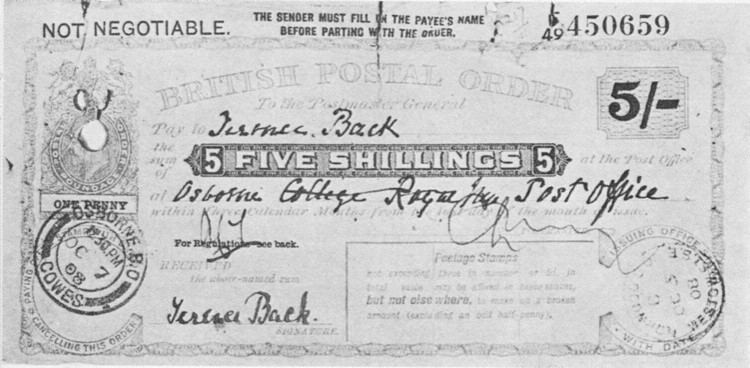 | ||
A postal order is a financial instrument usually intended for sending money through the mail. It is purchased at a post office and is payable at another post office to the named recipient. A small fee for the service, known as poundage, is paid by the purchaser. In the United States, this is known as a postal money order. Postal orders are not legal tender, but a type of promissory note, similar to a cheque.
Contents
History in the United Kingdom
The postal order is a direct descendent of the money order, which had been established by a private company in 1792. During World War I and World War II, British postal orders were temporarily declared legal tender to save paper and labour. Postal orders can be bought and redeemed at post offices in the UK, although a crossed postal order must be paid into a bank account. Until April 2006 they came in fixed denominations but due to increased popularity they were redesigned to make them more flexible and secure. They now have the payee and value added at the time of purchase, making them more like a cheque. The fee for using this form of payment falls into one of three bands - details are available on the Post Office website. The maximum value of postal order available is £250.00 with the fee capped at £12.50.
Despite competition from cheques and electronic funds transfer, postal orders continue to appeal to customers, especially as a form of payment for shopping on the Internet, as they are drawn on the Post Office's accounts so a vendor can be certain that they will not bounce. They also enable those without a bank account, including minors, to make small financial transactions otherwise than in cash. Postal workers in the United Kingdom use voided or cancelled orders in their training.
International use of the British postal order
The use of postal orders (or postal notes in some countries) was extended to most countries that are now part of the British Commonwealth of Nations, plus to a few foreign countries such as Jordan, Egypt and Thailand.
The United States
United States Postal Money Orders appear facially as a draft against an account held by the United States Postal Service, and the United States Postal Service requires a purchaser to know, in advance, where presentment of the instrument will occur. Only special, more expensive United States International Postal Money Orders may be presented abroad. In the United States, international money orders are pink and domestic money orders are green.
Canada
Canada Post issues two types of money orders: peach coloured, for Canadian Dollars, and green for US Dollars. Money orders in Canadian Dollars (fee code "0") are valid in Canada, Fiji, and most of the West Indies. Money orders with fee code "1" are valid in the United States of America and its dependencies. All Canada Post money orders incur the same fee for purchase ($7.00). The validity for individual destination countries can be found in the Canada Post International Destination Listing.
Collecting
Postal orders are gaining in popularity as collectibles, especially among numismatists who collect banknotes.
There is an active numismatic organisation in the UK called the Postal Order Society that was established in 1985 with members both domestically and overseas. They hold twice-yearly postal auctions of postal orders and related material from across the British Commonwealth.
Canteen orders
A Defence canteen order was a variant of a postal order used in Australia during World War II. Purchased at a post office, it was payable to an enlisted person in goods from a canteen rather than being a cash instrument.
